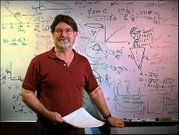Echo of the Big Bang Wins Nobel Prize


Astrophysicists John Mather (left) of NASA's Goddard Space Flight Center and George Smoot (right) of the University of California at Berkeley were awarded the Nobel Physics Prize for experiments that provided critical support for the "Big Bang" model of the Universe. The scientist’s experiments were carried out on the unmanned NASA spacecraft, COBE, and their results were described by physicist Stephen Hawking as "the greatest discovery of the century, if not all times."
Readers will note that I did not attempt a prediction of the physics winners after failing to call the medicine winner on Sunday.
I had predicted that Sir Alec Jefferys, FRS, would win the medicine prize for his pioneering development of DNA fingerprinting. Yesterday, the Nobel Committee ignored my choice and selected, instead, Andrew Z. Fire of Stanford University and Craig C. Mello of the University of Mass. Medical School: “for discovering a method of turning off selected genes, an important research tool that scientists hope will lead to new treatments for HIV, cancer and other illnesses.” The scientists were honored for their recent discovery of RNA interference, which it called "a fundamental mechanism for controlling the flow of genetic information."
Since the first description of DNA by Watson and Crick, the central dogma of biology has held that genes written in the DNA were recipes for proteins, the building blocks of living organisms. The RNA molecule was thought to be the messenger that read information from the DNA code and took it to protein-building machines inside the cell.
But experiments by Mello and Fire found that RNA could do a lot more than ferry notes from the DNA to the rest of the cell. Mello was looking for a way to turn off specific genes so he could understand their function. He tried inserting pieces of RNA, and found that they were able to shut off the genes. The RNA was blocking RNA messages. Later research by Mello and Fire revealed this kind of RNA-- known as RNAi, for RNA interference-- exist in plants, fruit flies and even people. They regulate more than a third of all proteins and could be linked to cancer and other diseases.
Merck is using RNAi technology to switch off genes in lab animals it is using in drug discovery. And two companies, Alnylam Pharmaceuticals and Sirna Therapeutics, are trying to develop RNAi as a drug against diseases like macular degeneration, cystic fibrosis and pandemic flu and the Ebola virus.
Mello and Fire are excellent choices for the Nobel, but thus far I’m zero for one.
Mather and Smoot are also super choices for the physics prize. The COBE space probe was launched in November 1989. More than a thousand researchers and engineers worked on the COBE project, which Mather also coordinated.
Mather’s first experimental results provided "a perfect blackbody spectrum," a temperature profile of the Universe billions of years after the Big Bang, refining the 1965 measurements by physicists at Bell labs. This so-called cosmic microwave background (CMB) radiation left over from the Big Bang when the universe was born, today has a temperature that is only 2.7 degrees above absolute zero.
Smoot's prize was for measuring tiny variations in the temperature of the CMB believed to be due to early universe sound waves caused by the struggle between gravitation and radiation pressure as the universe expanded. Smoot's data provided a value of the normal matter (nucleon) density ratio of 0.04 consistent with a universe dominated by dark energy and dark matter, with the normal matter accounting for only 4%.
"These measurements marked the inception of cosmology as a precise science," the Nobel jury said in its citation.
While I'm not predicting the winner of the chemistry prize to be announced tomorrow, the favorite over at the Thompson Scientific web site is Tobin Marks “for his research on new materials having remarkable electrical, mechanical, photonic and interfacial properties.” Marks research is in leading edge interdisciplinary materials chemistry of thin film photonic materials for high-speed data transmission; molecular assemblies in which intermolecular interactions are subject to chemical tuning; and high-quality films of ferroelectrics, dielectrics, and transparent conductors.
Stay tuned science fans.

3 Comments:
Those are pretty exciting times, science wise at least ---Just finished an excellent article in The Smithsonian (Oct. 2006) called The Search of New Planets by Robert Irion.
Thank you for all your fascinating and challenging posts.
Sincerely,
Marie-France
10 04 06
Hey Bill:
I am still working on the post in inequivalent reps but wanted to pass a link onto you that I thought you might enjoy. It is to the recent PHYSICS TODAY online article about how a lot of theoretical physics is headed more towards theological mysticism! Check it out! In the meantime, I hope you are having a good week:)
Hey Bill,
I've been following ID for a while, and wondered why the seminal work by Dembski and Behe are hardly mentioned for Nobel Prizes? This is truly seminal work, a very novel approach to evolutionary biology, and I think these guys get short shrift. What do you think?
Post a Comment
Subscribe to Post Comments [Atom]
<< Home